

Toledo District map - from www.Belize.net
|
|
|
|
Toledo District map - from www.Belize.net |
|
Jay and I were looking for our usual February get-a-way this year and started out planning a sailfish trip to Costa Rica. Bad timing put a sail tournament right on our week so we began looking at our options. Looking at the full-moon we figured bonefishing would be off so we decided to tackle permit in hopes of breaking Jay's long running skunk on these fish. I was confident after managing to land three last year in the Yucatan though my luck in Key West didn't hold with only one fish on and lost after four days of fishing there. The Gulf of Honduras looked like the spot to get the most shots so we booked at El Pescador Punta Gorda, tied crab flies, and headed to Belize for 6 days of fishing on the permit flats there.
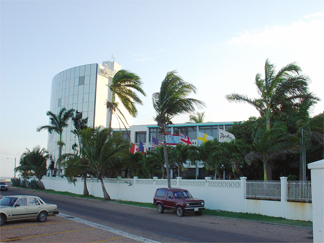 |
We arrived in Belize City via Houston which was a pretty painless
flight. We spent one night in Belize City at the Radisson which
was one of the better hotels in the area. Belize City is not
Cancun, it is definitely a third world city that is known for crime in
many areas and not too conducive to roaming around after dark which came
shortly after we arrived. Instead we spent the evening at the
hotel talking to the bartender, a Guatemalan who I could at least
hablo en español with.
I found Belize to be a very diverse and interesting culture. It felt more like the Bahamas than Mexico but you heard English (the official language), Creole, Spanish, and Mayan all spoken at various times. |
We got up early in the morning to head to the Municipal Airport in Belize City to catch our flight to Punta Gorda. The flight took us to Dangriga, Placencia, and finally to Punta Gorda.
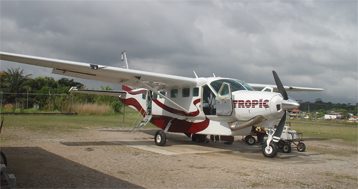 |
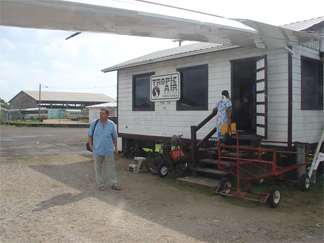 |
|
Our Caravan |
The Punta Gorda Airport |
We went from the plane right to our boat to fish the day before finally seeing the lodge. That day we had lots of wind and rough conditions but still managed to get shots at about 9 permit which we thought was pretty good, we soon found out that was nothing. Our big mistake that day was to fish our 9-weights, they just could not handle the wind with the heavy crab flies. That night we rigged up our 10-weights and stuck to them for most of the duration for permit. Paul, our guide, was pretty good at finding the fish for us, we just had trouble getting decent casts off to them.
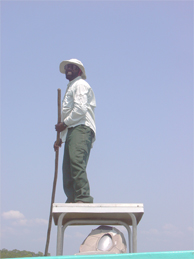 |
|
Paul spotting permit |
The second day of fishing took us back to the flats of Port Honduras Marine Reserve and the Point Ycacos Lagoon, the two areas we hit hardest for permit.
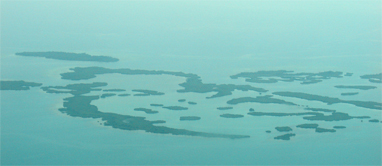 |
 |
|
Port Honduras Cayes - home of permit flats |
Point Ycacos Lagoon entrance |
This day we saw a LOT of permit, or so we thought. We had seen about 30-35 fish and again thought that was a good day. After talking to the staff we found out that an average day is more like 50 fish with a good dozen shots. We had quite a few fish follow our flies this day but no takers yet. We got out of our skunk by catching some incidental snapper that intercepted the flies as we fished for permit. One guest, Rob, had managed his first permit this day in the lagoon which gave us hope.
Day three brought better conditions and quite a few permit sightings. We were getting follows again and I finally got one to eat the fly out on a flat but missed the hookup on it. My permit batting average just went from .500 (3/6) to .429 (3/7). We agreed at the end of the day that we would go catch bonefish the next day just to catch a break from permit so we rigged up our 7-weights when we got back to the lodge.
Day four dawned with perfect conditions. Paul talked us into hitting the lagoon before heading out for bonefish since the wind finally had laid down and the permit should be on the feed. We did find fish pretty quickly in the lagoon in singles and small schools. After messing up on a few good shots we found a big permit feeding. As we headed to him a school of smaller fish showed up in between and Jay took his shot. On about the third cast the reel began to scream. After a few good runs the 5 lbs. permit came to net, the skunk had been broken.
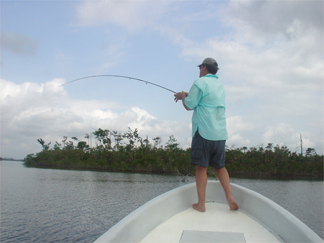 |
 |
| Fish On! | That first permit - what a relief |
I managed to mess up the big fish who was still feeding amazingly enough and we fished a bit longer before saying, "Let's go have fun in the river". We went up the Deep River and cast Whistlers and Jay's new funky slider fly around the edges. In about 3 casts my fly hit the water and disappeared in a boil. I landed a pretty nice spanish mackerel which was surprising given the 20 lbs. bite tippet I had on. Jay got a nice cuda on his green slider thing and I also got a fairly good sized yellowtail snapper on the Whistler. I thought for sure it was a snook given the pull back into the mangroves and was a bit disappointed when the snapper appeared. We thought we saw a tarpon roll but never located him to make a cast to him.
That night Jay got to drink from the chalice, the award for landing a permit. Given the time it took he just decided to forgo the chalice and pour from the bottle...
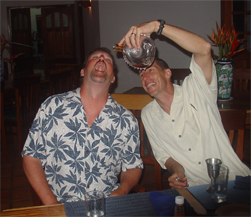 |
 |
|
Jim pouring Jay his reward |
At the Permit award station. L-R: Rob, Meredith, Me, Jay, and Jim |
Day five we did go to the reef and hit the bonefish flats, we really needed the break and I needed to catch some fish that I was sight fishing to. We took the 30-mile run to the Sapodilla Cayes Marine Reserve in totally flat seas. We could see Guatemala to the south with the clear skies. We gave Paul a reel for his rod and gave him a few flies so he could fish the day too since neither Jay nor I needed a guide for bones.
We hit Nicholas Cay first where we walked to the beach and saw about 100 bonefish schooled up and nosed into the beach. I wish I'd had my camera ready, it was quite the sight. Within a minute we all were hooked up and landing bones. We left Paul with the school while Jay took off to the right and I took off to the left in search of singles and doubles feeding on the strip flat.
 |
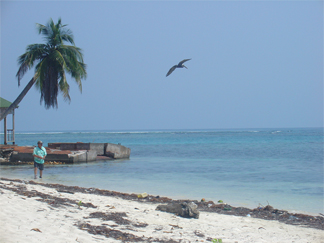 |
| Landing at Nicholas Cay | Beach fishing for bones |
I had a good time on this cay, getting 6 bones all on my pink rubber/rabbit Gotcha variation. Since I love beach fishing I was enjoying this a lot, you walked the beach looking ahead for a bone then cast when they got in range. At one point I got three fish on three casts, that is hard to beat. I met up with Jay on the far side of the island and he had done about the same as me and had also seen a permit. We walked back to find Paul still hitting the school and he had landed about 15 bones. I switched flies to a pink Squimp to test it out after proving my rubber/rabbit Gotcha fly in it's third country.
We took off to Frank's Cay and NE Sapodilla Cay next where there was a school of very small fish working in one spot that Paul got into quickly. I fished a small group of very spooky fish in very skinny water to no avail before taking a hike. A very nice fish came onto the flat by the pier and I got him to take my pink Squimp on the first cast. This was the nicest fish I landed, an 18" bone with some girth to him. I had a unique experience though, Frank's Cay has some houses on it and when I was fighting the fish a few dogs came down. One jumped in and began going for the fish. I've had sharks go after my bonefish but never a dog but I yelled the dog off and landed the fish safely. Jay worked out on the reef and managed a nice trigger fish and then on the reef side of NE Sapodilla Cay got a 19" bone which was the nicest bonefish of the trip and a 10 lbs. trigger.
Paul caught fish after fish here and even managed to hook up 3-4 fish while another guide was working the flat with clients. I think those guys realized they had hired the wrong guide.

Our last stop was Hunter Cay where the park headquarters was located. There was a school of bigger bones there that didn't seem to want to take well and I quickly left them to Paul. I worked a strip flat just south of the boat and managed to get another 4 fish to take there on a very small Gotcha.
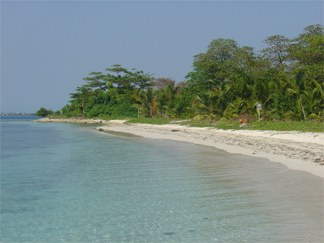
Jay and I stopped fishing and went to sit in the shade on the pier. We saw some jacks working the water so I rigged up a Clousers and waited for them. On their next attack wave I cast where they were but hooked up a bonefish instead. I was pretty pleased with the bonefish experience, it was the first time I just took off totally on my own and landed bonefish and I ended up with 12 fish for the day. Paul kicked our butts in the school. He finally got 6 of the bigger fish to take and for the day managed about 35-40 bonefish. We figure we landed 50 between us, pretty good for only a few hours of fishing out there.
On our last day we hit the permit again, hoping to get me into a fish finally. The lagoon had fish in the morning and Jay managed to hook up a big fish of about 20 lbs. that ended up wrapping around an underwater stick and breaking off. Out on the flats I got one decent fish to take that crushed the crab fly, my average dropped to .375 on that one. We had the opposite of our first days of too much wind, we had no wind and totally flat water which made the permit extra paranoid (are you really paranoid if people ARE trying to get you?) and spooky. Heading in we toasted a few Belikins over a successful trip. The goal was to get Jay his fish and it happened with a bonus of hooking a big one. At least I could still say "Well, I've still caught more permit" even though I seem stuck at three fish in to hand after 3 trips. If I ever decide to dedicate a trip to permit again though I'd return to Port Hondura, it does have a huge population of permit.
Aside from permit the area was alive with wildlife which made it enjoyable just to be outside. Every day our alarm clock was the groups of howler monkeys that live in the area, they started up at around 5:30-6:00 each day. I saw one small one the first day there and then on our last morning a whole family showed up in a tree we could spot at breakfast.

The other main guest of the lodge was a flock of Montezuma birds which made quite the racket also each morning. They were a pretty bird with a black body and a yellow tail. I found a group of their nests when hiking on the last day in a large Ceiba tree.
 |
 |
There were other assorted birds, lizards, pacas, and toads that we encountered at the lodge. Surprisingly enough we didn't have too many bugs, snakes, or other nasty critters to deal with. We thought we heard a jaguar one evening but I never managed to find tracks of the elusive cat.
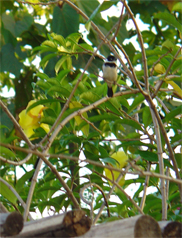 |
 |
Out on the flats we encountered many marine birds, rays, and the usual sea bottom dwellers like starfish and sea cucumbers.
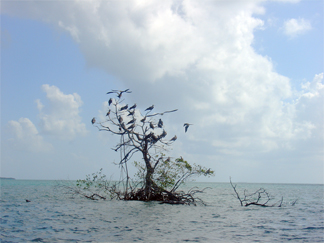 |
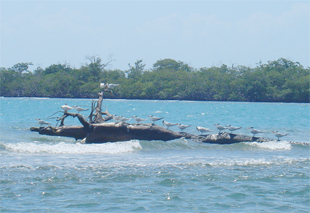 |
| The Frigate tree | The Tern tree - I had a permit take just left of here |
 |
 |
| Leopard Ray | Black Ray |
 |
 |
| One of many orange starfish | The coral garden by the reef |
On our last day I chose to hike a small loop through the jungle and the lodge property just to get out and move my legs before sitting in planes the rest of the day. The trail first heads down the hill, follows the river a ways in the jungle, moves up a road into orchards and gardens, then back up the drive to the lodge. This short loop took about 40 minutes. The long loop that has more jungle takes you to the hills to the west and takes a few hours which I didn't want to tackle.
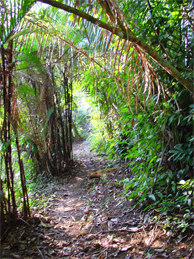 |
 |
| Down the jungle trail | Large Ceiba tree |
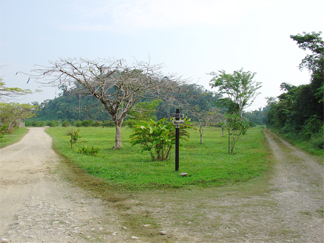 |
 |
|
Big Hill at the fork in the roads |
|
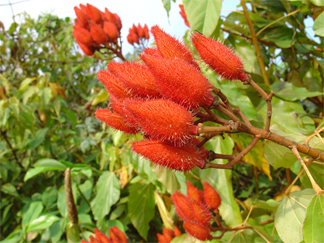 |
|
The lodge, unlike most saltwater lodges, is set on Big Hill along the Rio Grande. Each day you take a tram down the hill to the docks or walk the 350+ steps to get down the hill.
 |
 |
|
The tram and stairs |
The boat dock |
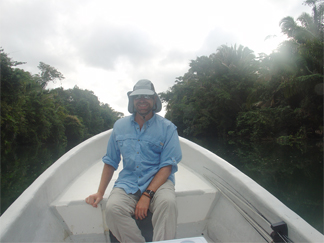 |
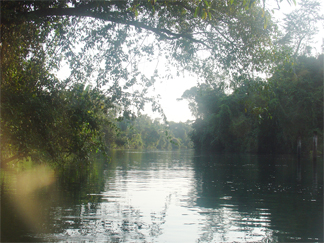 |
| Riding down the river | The Rio Grande in the morning |
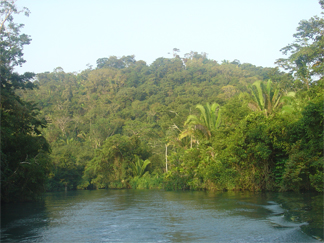 |
|
| Big Hill from the river | |
The lodge on the hill consists of 7 cabins, a pool area, and a main lodge that contains a gym, a bar/rec room, a fly shop, and a dining room. The rooms were very nice with two beds, a sitting area, rod racks, and lots of storage. The pool sure felt good after a day on the water, it was a good way to cool down before showering and getting ready for dinner.
 |
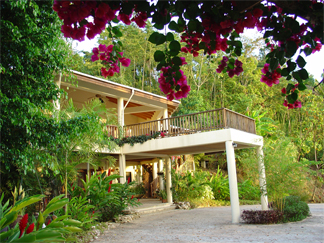 |
|
The main lodge from the drive (L) and the pool area (R) |
|
 |
 |
| Our cabin | Pool area |
 |
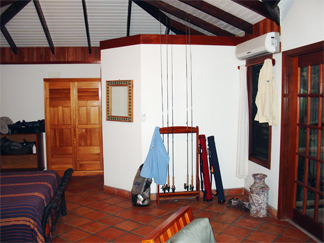 |
| Interior of cabin | |
 |
 |
| The bar/rec room | The grounds from the dining deck |
Aside from the fishing and hiking, the lodge offers many other eco-tour opportunities. One can take a kayak or canoe onto the Rio Grande which we had wanted to do but were just too worn out at the end of the day to do. You can also do land trips to several National Parks in the Toledo District or visit the Mayan ruins at Lubaantun where the famous Crystal Skull was found. The snorkeling opportunities at the reef would be plentiful including snorkeling a shipwreck which Rob and Meredith had done when they went out there.
The staff was excellent in every way and very friendly. There weren't many guests some nights so Jay and I hung in the bar playing cribbage and talking to the staff about Belize. Jay also spent time coaching one staff member in the art of pool sharking.
I would recommend taking at least three rods - a 6-7 weight for bonefish, an 8-10 weight for permit and a 10 weight for whatever else. I took a 7, 9, and 10 Sage RPLXi. We found that the wind was enough most days that the 10-weight was the perfect permit rod and kept a 9 rigged for cuda in the boat. We threw the 9's the first day and just couldn't cast into the wind with it, on calm days you could get away with it better. I use Ross Big Game reels in size 4 for the 6 & 7 and size 6 for the 10-weight. For lines I stick with the SA Bonefish taper though I throw one size up from the rod recommendation. For permit I used a 9' 16 lbs. leader with a 2' 0x flouro tippet. For bones you can get away with a 9' 8 lbs. leader pretty easily.
 For
permit two flies seemed to draw strikes. One was a green raghead crab, I
got one fish to eat that one. The other was Jay's 12-year old aged crab
pattern that hooked two fish and got crushed by another fish. We
also threw some Puglessi crabs which got some looks, a tan raghead in the
lagoon which got a few looks, Merkins in brown/tan and olive/tan, and the
J-Crab. All flies got some looks but this olive crab was the one that they
seemed most interested in eating.
For
permit two flies seemed to draw strikes. One was a green raghead crab, I
got one fish to eat that one. The other was Jay's 12-year old aged crab
pattern that hooked two fish and got crushed by another fish. We
also threw some Puglessi crabs which got some looks, a tan raghead in the
lagoon which got a few looks, Merkins in brown/tan and olive/tan, and the
J-Crab. All flies got some looks but this olive crab was the one that they
seemed most interested in eating.
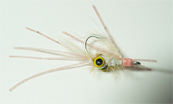 For
bonefish the fly didn't seem to matter too much, these were pretty easy fish.
I got fish on a Gotcha, my pink rubber Gotcha, and a pink version of the Squimp
which I'd been playing with for the Yucatan trip coming up. I got my
biggest bonefish on this pattern tied on a #8 hook but it was a bit large for
some of the smaller fish where a #8 Gotcha did the trick. Bones also took
the J-Crab and Da Worm - both foam flies created by Jay - and a Chartreuse
Clousers Minnow.
For
bonefish the fly didn't seem to matter too much, these were pretty easy fish.
I got fish on a Gotcha, my pink rubber Gotcha, and a pink version of the Squimp
which I'd been playing with for the Yucatan trip coming up. I got my
biggest bonefish on this pattern tied on a #8 hook but it was a bit large for
some of the smaller fish where a #8 Gotcha did the trick. Bones also took
the J-Crab and Da Worm - both foam flies created by Jay - and a Chartreuse
Clousers Minnow.